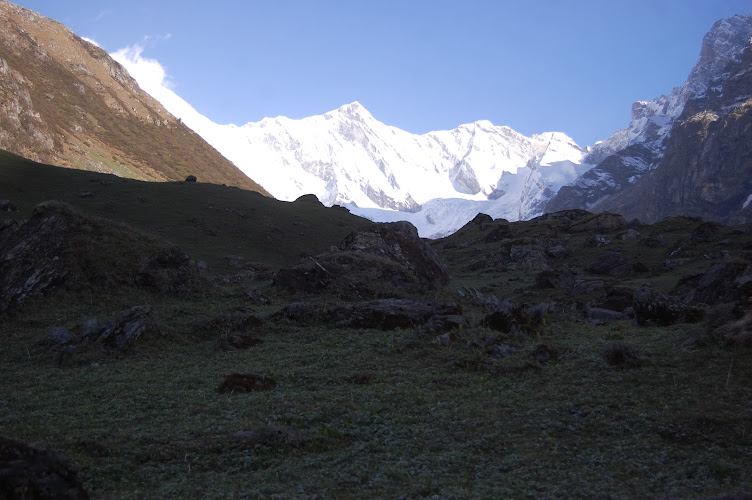

API NAMPA CONSERVATION AREA - Trans-Himalayan Biodiversity Hotspot
10100
Nepal's youngest conservation area hides in the country's most remote corner, where far-western mountains soar toward Tibet and villages cling to slopes so steep that fields require terracing at angles approaching the vertical. Api Nampa Conservation Area, established in 2010 and named for twin peaks—Api at 7,132 meters and Nampa at 6,757 meters—sprawls across 1,903 square kilometers of the Darchula district, ranging from 518-meter river valleys to the ice-draped summit of Api, western Nepal's tallest mountain. Part of the sacred Kailash Landscape spanning Nepal, India, and Tibet, Api Nampa protects ecosystems so biodiverse that scientists cataloging species here regularly discover flora and fauna previously unknown to science.
The numbers alone stagger: 535 angiosperm species, 12 gymnosperms, 69 pteridophytes, 43 mammals, 263 birds, 69 fish, and at least 64 insects—and counting continues. The extraordinary biodiversity stems from Api Nampa's remarkable elevation gradient compressing multiple climate zones into compact geographic space. Subtropical river valleys support sal forests and agricultural terraces, mid-elevation slopes harbor oak and rhododendron, higher zones transition to coniferous forests of pine and fir, and above tree line, alpine meadows burst with wildflowers each summer before giving way to permanent snow and ice. This vertical ecosystem stacking creates habitats for species ranging from jungle cats in lowland forests to snow leopards prowling ridges above 4,000 meters.
The grassland plateau at Api Nampa's heart represents its ecological crown jewel, a high-altitude expanse bordered by dense forests and glacial rivers where rare Himalayan species congregate. Red pandas inhabit mid-elevation bamboo thickets, their russet coats flashing through undergrowth as they feed on bamboo shoots and search for tree hollows to shelter cubs. Snow leopards leave pugmarks across scree slopes, their populations among Nepal's healthiest thanks to abundant blue sheep that graze impossibly steep terrain. Himalayan tahr, musk deer hunted nearly to extinction for their scent glands, Himalayan black bears, common langurs, goral, and serow complete the mammal assemblage adapted to altitude and isolation.
Bird diversity peaks during spring and autumn migrations when Himalayan specialties mix with passage migrants. The kalij pheasant, blood pheasant, and multiple species of laughing thrushes inhabit forests, while high-altitude specialists like the Himalayan snowcock and alpine chough patrol barren zones above tree line. Raptors—golden eagles, Himalayan griffons, lammergeiers with their distinctive diamond-shaped tails—ride thermals above ridges, scanning for prey or carcasses.
Cultural richness matches ecological diversity. The Byansi people inhabit Api Nampa's valleys, maintaining trans-Himalayan trading traditions that predate Nepal's unification. For centuries, Byansi traders crossed high passes into Tibet, exchanging lowland grain for salt and wool in commerce patterns that only ended when China closed borders following the 1959 Tibetan uprising. These communities preserve unique dialects, architectural styles, and agricultural systems adapted to marginal lands through generations of accumulated wisdom.
Access to Api Nampa demands serious commitment. From Kathmandu, the journey involves flying to Dhangadhi, driving two days to Gokuleshwar, then trekking several days to reach the conservation area's interior. Few tourists attempt this odyssey—annual visitor numbers barely reach triple digits—ensuring wilderness solitude increasingly rare across Nepal's protected areas. The Api Himal Base Camp trek attracts occasional mountaineering groups and hardcore trekkers seeking routes untainted by crowds, but infrastructure remains minimal with basic campsites rather than teahouse networks.
Conservation challenges include cross-border wildlife management requiring coordination with Indian and Chinese authorities, poaching pressures on musk deer and other high-value species, and climate change impacts manifesting through glacier retreat and altered precipitation patterns. The remoteness that protects Api Nampa from mass tourism also complicates enforcement, with vast terrain and limited ranger numbers allowing illegal activities in zones rarely patrolled.
Yet Api Nampa's very obscurity offers advantages. Without tourism pressures driving infrastructure development, the area retains authenticity impossible to preserve in more accessible regions. The Byansi people continue traditional practices with minimal outside interference. Wildlife populations function according to natural dynamics rather than human manipulation for viewing opportunities. In an increasingly crowded Nepal where even remote valleys fill with teahouses and trekkers, Api Nampa endures as genuine wilderness—a landscape shaped by geology and ecology rather than human intervention, where isolation equals preservation and the greatest protection comes from simply being too far off any beaten path for casual visitors to bother attempting the journey.
Park Features & Amenities
🏃 Activities
- ✓ Hiking
🎠 Children
- ✓ Good for kids
- ✓ Kid-friendly hikes
Visitor Information
🕐 Best Times to Visit
Spring (Mar-May): Pleasant weather, blooming flowers
Autumn (Sep-Nov): Clear skies, comfortable temperatures
Early Morning: Best for wildlife viewing and photography
🗺️ Getting There
By Car: 10100
Public Transport: Local buses and taxis available
Walking: Check distance from city center
💡 Visitor Tips
• Bring water and sun protection
• Wear comfortable walking shoes
• Check weather conditions before visiting
• Bring camera for nature photography
Explore More in Nepal
Nearby Attractions
Popular Activities
Ready to Visit API NAMPA CONSERVATION AREA?
Plan your visit to this amazing destination with our comprehensive travel guide and insider tips.
Seasonal Travel Guide
Weather & Best Time
Winter brings cool temperatures (5-15°C) with clear skies and snow-capped peaks. Perfect for mountain views but cold at higher altitudes.
Best Activities:
- Mountain viewing
- Cultural experiences
- Spa and hot springs
- Photography of snow peaks
- Indoor cultural activities
Travel Tips
- Visit during December-February for snow-capped views
- Pack warm clothing for cold temperatures
- Book hotels with heating facilities
- Plan for shorter daylight hours
Packing Suggestions:
- Warm winter clothing
- Thermal layers
- Warm hat and gloves
- Sturdy winter boots
- Hot water bottle
Quick Facts
Best time: Autumn (Sep-Nov)
Duration: 1-3 days
Difficulty: Easy
Cost: Budget-friendly